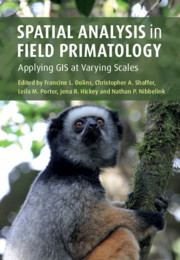Book contents
- Spatial Analysis in Field Primatology
- Spatial Analysis in Field Primatology
- Copyright page
- Dedication
- Contents
- Contributors
- Acknowledgments
- 1 Why Place Matters, and its Use in Primate Behavioral and Ecological Research
- Part I GPS for Primatologists
- Introduction
- 2 Fundamentals of GIS and GPS
- 3 “Next-Gen” Tracking in Primatology
- 4 The Ethical Implications, and Practical Consequences, of Attaching Remote Telemetry Apparatus to Macaques
- 5 Processing Geospatial Data in R
- 6 Estimating Travel Distance and Linearity of Primate Routes
- Part II GIS Analysis in Fine-Scale Space
- Part III GIS Analysis in Broad-Scale Space
- Index
- Plate Section (PDF Only)
- References
6 - Estimating Travel Distance and Linearity of Primate Routes
Ideas on How to Clean and Smooth Track Data Collected with a Handheld GPS
from Part I - GPS for Primatologists
Published online by Cambridge University Press: 29 January 2021
- Spatial Analysis in Field Primatology
- Spatial Analysis in Field Primatology
- Copyright page
- Dedication
- Contents
- Contributors
- Acknowledgments
- 1 Why Place Matters, and its Use in Primate Behavioral and Ecological Research
- Part I GPS for Primatologists
- Introduction
- 2 Fundamentals of GIS and GPS
- 3 “Next-Gen” Tracking in Primatology
- 4 The Ethical Implications, and Practical Consequences, of Attaching Remote Telemetry Apparatus to Macaques
- 5 Processing Geospatial Data in R
- 6 Estimating Travel Distance and Linearity of Primate Routes
- Part II GIS Analysis in Fine-Scale Space
- Part III GIS Analysis in Broad-Scale Space
- Index
- Plate Section (PDF Only)
- References
Summary
Primatologists use data collected by GPS devices to answer a wide variety of scientific questions. GPS data on locations where individuals were recorded as present or absent can provide insight into primate genetic diversity, dispersal patterns, densities, and habitat suitability (e.g., Guschanski et al. 2009; Hickey et al. 2012; Junker et al. 2012; Kouakou et al. 2009). GPS data on locations of primates’ daily travel paths provide an even wider range of information. Knowing how locations change over time can inform us on disease transmission probabilities, the impact of seasonality in food availability, or differences in social organization (e.g., Lehmann & Boesch 2005; Olupot et al. 1997; Walsh et al. 2005). Calculations of travel distances reveal indices of energy expenditure (e.g., Steudel 2000), while calculations of travel speed provide information on vigilance behavior, levels of food competition, and anticipation of food finding (e.g., Janmaat et al. 2006; Noser & Byrne 2009; Pochron 2001). In addition, travel shape (e.g., linearity of or directional changes in the travel path) can help us reveal cognitive abilities, such as spatio-temporal memory or planning skills (Milton 2000; Noser & Byrne 2007; Valero & Byrne 2007). Lastly, knowledge about directional changes improves our understanding of the importance of specific locations in the habitat, such as fruit trees (Asensio et al. 2011; Byrne et al. 2009). Within this large number of studies, very few reported that GPS devices make errors that can affect the scientific conclusions that are drawn. Even fewer studies investigated how we can limit or correct these errors. In this chapter, we therefore discuss the issues we encountered when using a handheld commercial GPS device (Garmin GPSMAP® 60CSx) to estimate travel locations of wild chimpanzees (Pan troglodytes verus) in a West African rain forest. We present methods we used for testing the accuracy of the GPS device and provide primatologists with ideas on how to clean and smooth track data.
- Type
- Chapter
- Information
- Spatial Analysis in Field PrimatologyApplying GIS at Varying Scales, pp. 106 - 120Publisher: Cambridge University PressPrint publication year: 2021
References
- 2
- Cited by



